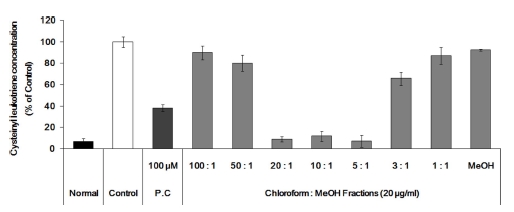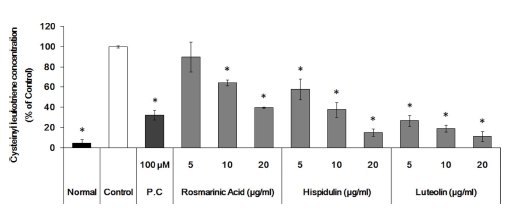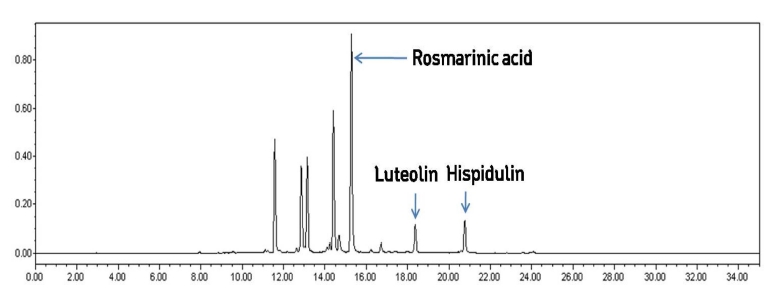
3종의 배암차즈기에 대한 염증억제 활성 비교 및 활성성분 구명
© The Korean Society of Medicinal Crop Science. All rights reserved.
This is an Open-Access article distributed under the terms of the Creative Commons Attribution Non-Commercial License ( http://creativecommons.org/licenses/by-nc/3.0 ) which permits unrestricted non-commercial use, distribution, and reproduction in any medium, provided the original work is properly cited.
Salvia has been widely cultivated for use in flavoring and folk medicines in many countries, including Korea and China. In this study, we investigated the anti-inflammatory activity and the underlying active compounds of Salvia extract and its fractions.
The anti-inflammatory activity was measured by assessing the inhibition of cysteinyl leukotriene production in rat basophilic leukemia (RBL)-2H3 mast cells. Salvia plebeia R. Br. was found to have the most potent inhibitory activity on leukotriene production than S. japonica and S. chanroenica had. Fifty percent ethanol extracts of S. plebeia R. Br. were successively partitioned with n-hexane, methylene chloride, ethyl acetate, 1-butanol and water. The ethyl acetate (EtOAc) fraction showed stronger anti-inflammatory activity than other solvent fractions did. The EtOAc fraction was subjected to silica gel column chromatography elution with a chloroform and methanol gradient system (100 : 1 → 1 : 1) yielding 10 fractions. Three kinds of fractions (chloroform:methanol = 20 : 1, 10 : 1 and 5 : 1) showed high inhibitory activity on leukotriene production. We confirmed the major compounds with anti-inflammatory activity from S. plebeia R. Br.
In this study, the major components of S. plebeia that showed leukotriene production inhibitory activity were isolated using solvent extraction and silica gel column chromatography. Rosmarinic acid, hispidulin and luteolin were identified as the major compounds with anti-inflammatory effect.
Keywords:
Salvia plebeia, Anti-inflammation Activity, Hispidulin, Leukotriene, Luteolin, Rosmarinic Acid서 언
천식 (asthma)이란 여러 자극에 대한 기도의 과민성을 그 특징으로 하는 질환으로 대부분의 천식은 알러지성이며, 만성 기도염증과 기도 과민반응성이 특징이다 (Minoguchi and Adachi, 1999; Shimizu et al., 2013). 천식은 그 원인에 따 라 집먼지진드기, 꽃가루, 동물의 상피, 곰팡이 등의 항원에 노 출되었을 때 증상이 나타나는 외인성 천식과 상기도 감염, 운 동, 정서불안, 한랭 기후 및 습도의 변화 등이 증상을 유발 혹은 악화시키는 내인성 천식 그리고 약물 유발성 천식, 운동 유발성 천식 및 직업성 천식 등이 있다 (Beasley et al., 2015).
천식은 T helper type 2 면역세포가 생성하는 싸이토카인인 인터루킨-4, 5, 13 (IL-4, IL-5, IL-13)에 의해 염증세포가 증 식, 분화 및 활성화되어 기도 및 기도 주변 조직으로 이동, 침윤하기 때문에 만성 염증질환으로도 인식되고 있다 (Elias et al., 2003; Wills-Karp et al., 1998; Wynn, 2015). 또한 천식 을 앓고 있는 환자의 기관지에서 활성화된 호산구, 비만세포, 폐포 대식세포 등의 염증세포는 leukotriene, prostaglandin 같 은 염증매개인자들을 분비하면서 강력한 기관지 수축작용에 관여한다 (Barnes et al., 1998; Maggi, 1998; Pawankar, 2001). 따라서 이들 싸이토카인과 염증매개인자들의 생산을 억 제하기 위한 약물을 개발하고자 많은 연구가 진행되고 있다.
배암차즈기 (Salvia plebeia R. Br.)는 꿀풀과 (Labiatae)에 속하는 일년생 또는 이년생 직립초목으로 우리나라 전 지역에 서 자생한다. 설견초, 청와초, 마마초, 과동청, 수양이 등으로도 불리며 성분으로는 flavonoids, homoplantaginin, rosmarinic acid, luteolin, hispidulin, eupafolin, eupafolin-7-glucoside 외 에도 페놀성 물질, 정유성분, 사포닌 등의 성분이 알려져 있다 (Choi et al., 2015a; Lim et al., 2007). 기존에 곰보배추 95% 에탄올 추출물의 관절염에 대한 억제효과 등의 선행문헌 이 있지만 특정 용매 추출물인 곰보배추의 10 - 60% 에탄올 추출물 또는 이로부터 분리된 정제물들의 호흡기염증 질환에 대한 치료효과가 연구된 바는 없다 (Jung et al., 2009).
Leukotriene은 arachidonic acid metabolism의 5-lipoxygenase (5-LO) pathway에 의해 합성되는 매개인자로 염증반응의 확인 을 위한 바이오마커로 사용하고 있다 (Goulet et al., 2000). 이 합성과정에서 leukotriene receptor에 길항작용하는 montelukast 같은 약물을 천식의 치료에도 사용하고 있다 (Drazen et al., 1999). 이에 본 연구에서는 호흡기염증 질환에 유효한 천연물 자원을 이용한 치료제 개발을 목표로 3종의 배암차즈기 추출 물을 대상으로 호염기성 백혈병 세포 (RBL-2H3 cell)을 이용 한 5-LO 억제 작용 실험을 통하여 염증 질환에 대한 치료효 과를 확인하고, 주요 활성성분을 구명하고자 한다.
재료 및 방법
1. 시약 및 재료
실험에 사용한 주정 (발효 에탄올)은 삼전순약공업주식회사 (Pyeongtek, Korea)에서, acetonitrile, chloroform, ethyl acetate, n-hexane, methanol, methylene chloride, 1-butanol은 Merck Millipore (Billerica, MA, USA)에서, dimethyl sulfoxide (DMSO), calcium ionophore, hispidulin, luteolin, montelukast, rosmarinic acid는 Sigma-Aldrich (St. Louis, MO, USA)에서, Dulbecco’s modified Eagle's medium (DMEM), fetal bovine serum (FBS), penicillin-streptomycin-amphotericin B (Antibotics), phosphate bufferd saline (PBS), 0.25% Trypsin-EDTA (TE)는 Gibco (Carlsbad, CA, USA)에서 구매하여 사용하였다.
2. 배암차즈기 조추출물 및 분획물 제조
배암차즈기 종류별 성분 및 활성 비교 평가를 위해서 한국 식물추출물은행에서 분양받은 배암차즈기 (PB4388.1, Korea Plant Extract Bank), 둥근배암차즈기 (PB4390.1, Korea Plant Extract Bank), 참배암차즈기 (PB4391.1, Korea Plant Extract Bank)의 메탄올 추출물을 사용하였다.
배암차즈기 추출물의 대량 제조를 위해 건조된 배암차즈기 (S. Plebeia R. BR., 2014년 4월 부안산) 지상부 500 g을 고 루 섞은 후 3차 증류수에 희석하여 제조한 0, 10, 30, 50, 70 혹은 90% 주정 10ℓ 이용해서 80℃에서 2.5시간동안 열 탕 추출하였다. 여액을 모은 후 잔사는 동일한 방법으로 재추 출 하여 그 여액을 합하여 45℃에서 배암차즈기 추출물이 건 조될 때까지 감압 농축하였다. 이후 2ℓ의 증류수를 가해 현 탁시킨 후 동결 건조하여 분말상태로 제조하였다.
배암차즈기 용매별 분획물은 50% 주정으로 추출한 조추출 물 50 g을 1차 증류수 1ℓ에 녹인 후 순차적으로 n-hexane 3ℓ, methylene chloride 3ℓ, ethyl acetate 3ℓ, butanol 3ℓ로 3회 반복하여 분획하여 제조하였다. 배암차즈기 ethyl acetate 분획물은 50% 주정으로 추출한 조추출물 40 g을 1차 증류수 2ℓ에 완전 용해시킨 후 분액 여두에 넣고 ethyl acetate 1ℓ에 잘 희석 시킨 후, 두 용매가 분리될 때까지 약 4시간 정도 방치하였다. 분리된 상층의 ethyl acetate 분획물을 취득하고 남은 여액에 다시 ethyl acetate 1ℓ로 총 3회 반복, 분획해 모은 ethyl acetate 3ℓ를 감압 농축하여 제조하였다.
Ethyl acetate 분획물 10 g을 silica column (Sigma-Aldrich Co., St. Louis, MO, USA)에 첨가시킨 후 chloroform과 methanol 비율 (100 : 1, 50 : 1, 20 : 1, 10 : 1, 5 : 1, 3 : 1, 1 : 1, methanol)을 달리한 용액으로 용출 및 건조해서 제조하였다.
3. RBL-2H3 세포 배양
Rat basophilic leukemia cell (RBL-2H3)을 10% FBS, 1% antibiotics가 포함된 DMEM (complete DMEM)으로 5% CO2, 37℃ incubator에서 T-75 culture flask에 배양하였다. 계 대 배양은 세포가 T-75 culture flask에 70 - 80% 가량 찼을 때, 배양액을 제거 및 PBS 3㎖로 세척하였다. 0.25% TE 용액 3㎖를 첨가하여, RBL-2H3 세포를 부유 상태로 만들 고 같은 양의 complete DMEM 배양액을 첨가 후, 1500 rpm, 4℃에서 5분간 원심분리를 실시하여 RBL-2H3 세 포를 침전시켰다. 이후 상층액을 제거하고 hemocytometer (Gibco, Carlsbad, CA, USA)로 세포수를 측정, 5 × 105 cells/ plate의 농도로 분주해 complete DMEM 배양액 10㎖로 배 양하였다.
4. Leukotriene assay
12-well plate에 RBL-2H3 cell을 5 × 105 cells/well만큼 분주 하여 complete DMEM 1㎖로 배양한다. 24시간 후 PBS 1㎖로 세척한 후 배암차즈기 추출물이 들어간 DMEM 500㎕로, 양성대조군은 100㎕M montelukast가 포함된 DMEM 500㎕로 10분간 배양한 후 1㎎/㎖ calcium ionophore 10㎕를 넣어 10분간 배양하였다. 이후 상층액을 모 아 1,500 rpm에서 원심 분리해 잔여세포를 침전시키고, 다시 상층액을 취해 −20℃에 보관한다. 상층액에 포함된 leukotriene 의 농도는 cysteinyl lekotriene EIA kit (ADI-901-070, Enzo Life Sciences Inc., Farmingdale, NY, USA)를 이용해 제조사 에서 제공한 방법으로 측정하였다.
5. 단일성분 확인 및 함량분석
실험에 사용한 추출물을 0.45㎛ syringe filter (Merk Millipore, Billerica, MA, USA)를 이용해 부유물을 제거하고 아래 표와 같은 조건에서 분석하였다 (Table 1, 2).
6. 통계 처리
실험결과는 평균값 ±표준편차로 나타내었으며 실험에서 얻 어진 결과의 통계적 유의성은 SPSS ver. 12.0 (statistical package for social science ver. 12, SPSS Inc., Chicago, IL, USA) 프로그램을 이용하여 t 검정을 시행하였다.
결과 및 고찰
1. 배암차즈기 종류별 항염증 효과 비교
배암차즈기 종류별 leukotriene 발생 억제 효과를 확인하기 위해 배암차즈기, 참배암차즈기, 둥근배암차즈기 메탄올 추출 물을 한국식물추출물은행으로부터 분양받아서 leukotriene 발 현 억제를 비교 평가하였다 (Fig. 1).
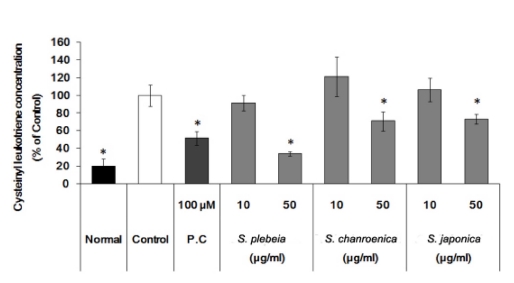
Effect of Salvias extract on leukotriene production inhibition.Mean values ± SD from triplicate separated experiments are shown. *p < 0.05, statistically significant different compared with control. P.C; Positive control (montelukast).
10㎍/㎖의 배암차즈기, 참배암차즈기, 둥근배암차즈기 조추 출물 처리하였을 때, 각각 91.2 ± 8.7%, 121.2 ± 22.3%, 106.3 ± 13.2%로 대조군 대비 유의미한 변화는 관찰되지 않았다 (p > 0.05). 하지만 농도를 50㎍/㎖로 처리하였을 때, 배암차 즈기, 참배암차즈기, 둥근배암차즈기는, 각각 34.3 ± 2.5%, 71.0 ± 10.7%, 73.4 ± 5.8%로 control 대비 leukotriene의 유의 미한 감소가 관찰되었으며, 이중 배암차즈기 조추출물이 가장 높은 leukotriene 발현 억제가 관찰되었다.
2. 배암차즈기 추출 주정 농도별 항염증 효과 비교
배암차즈기에서 다른 곰보배추들 보다 더 높은 leukotriene 발현 억제를 보여주는 바, 다양한 농도로 희석한 주정 (0 - 95%)으로 추출한 배암차즈기 조추출물을 50㎍/㎖의 농도로 처리해 각각의 추출용매에 따른 leukotriene 발현 억제를 정량 했다 (Fig. 2).
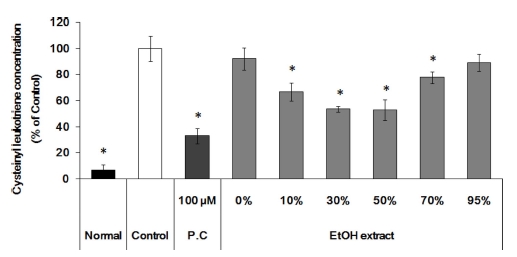
Anti-inflammation activity of fractions with different EtOH concentration.Mean values ± SD from triplicate separated experiments are shown. *p < 0.05, statistically significant different compared with control. P.C; Positive control (montelukast).
실험결과 10 - 50%의 주정에서 추출되었을 때, 각각 66.9 ± 6.8%, 53.6 ± 8.3%, 53.0 ± 7.7%로 다른 농도의 주정으로 추출한 조추출물보다 높은 leukotriene 발현 억제를 보였다. 이 는 Jung 등 (2009)이 수행했던 70% 에탄올 추출물 및 95% 에탄올 추출물보다 염증 유발물질인 leukotriene 생성을 강하 게 억제하여 보다 효과적인 추출 방법으로 볼 수 있다.
3. 배암차즈기 용매별 분획물의 항염증 효과 비교
배암차즈기 50% 주정 조추출물에서 n-hexane, methylene chloride, ethyl acetate, butanol, DW로 액체-액체 추출법을 이용해 얻은 분획물을 50 ㎍/㎖의 농도로 처리해 leukotriene 발현 억제를 확인하였다 (Fig. 3).
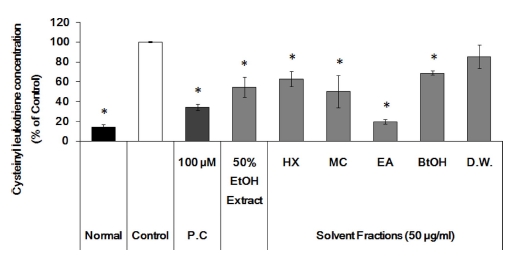
Anti-inflammation activity of fractions with different solvents.Mean values ± SD from triplicate separated experiments are shown. *p < 0.05, statistically significant different compared with control. BtOH; 1-Butanol, DW; Distilled water, EA; Ethyl acetate, HX; n-Hexane, MC; Methylene chloride, P.C; Positive control (montelukast).
용매 종류별 분획물에 대한 leukotriene 발현 억제 활성은 nhexane에서 62.9 ± 7.7%, methylene chloride에서 50.3 ± 16.3%, ethyl acetate에서 19.7 ± 2.4%, 1-butanol에서 68.8 ± 2.1%으로 control 군 대비 유의미하게 감소한 것을 확인할 수 있었다. 하지만 ethyl acetate 분획물을 제외한 다른 용매 분획물에서는 배암차즈기 50% 주정 조추출물과와 비슷하거나 보다 낮은 leukotriene 발현 억제를 확인할 수 있었다. 이를 통해 ethyl acetate 분획물이 가장 높은 항염증 활성이 나타남을 알 수 있 었다.
4. 배암차즈기 활성성분 분획물의 항염증 효과 비교
Ethyl acetate 분획물로부터 open chromatography법을 이용 해 chloroform과 methanol의 비율을 달리한 용매로 분획해 20㎍/㎖의 농도로 처리해 leukotriene 발현을 정량한 결과 chloroform:methanol의 비율이 20 : 1, 10 : 1, 5 : 1 분획물의 경우 control 대비 각각 90.8%, 88.0%, 92.8% leukotriene의 유의미한 발현 억제를 확인할 수 있었다 (Fig. 4).
5. Hispidulin, luteolin, rosmarinic acid의 항염증 효과 확인
기존에 발표된 연구에 따르면 배암차즈기에는 여러 생물학 적 활성물질이 포함되어 있다 (Choi et al., 2015b; Ren et al., 2014). 그 중 hispidulin, luteolin rosmarinic acid의 화합 물은 항염증효과를 가지고 있는 것이 많은 연구를 통해 알 려져 있다 (Liang et al., 2016). 실제 이들 화합물이 leukotriene 발현억제에 기여하는지를 확인한 결과, rosmarinic acid, hispidulin, luteolin을 각각 5, 10, 20㎍/㎖의 농도로 처 리하였을 때, 모두 농도의존적으로 leukotriene 발현 억제가 증 가하였다 (Fig. 5).
6. UV-spectrum을 이용한 배암차즈기 분획물 내 hispidulin, luteolin, rosmarinic acid 정성분석
높은 leukotriene 억제를 보인 silica column chromatography 20 : 1, 10 : 1, 5 : 1 분획물에 포함되어 있을 것으로 보이는 예 상되는 물질인 rosmarinic acid, hispidulin, luteolin의 UV spectrum과, HPLC로 물질을 분리해 각 peak별 용출 시간 및 UV-spectrum을 비교해 실제 배암차즈기 활성성분 분획물에 위 의 물질들이 포함되어 있는지 확인하였다 (Fig. 6).
Silica column chromatography 20 : 1, 10 : 1 분획물을 HPLC로 확인한 결과, 여러 peak중 40.2분경에 용리된 peak에 서 나타난 UV-spectrum은 단일 hispidulin의 UV-spectrum과 동일한 모양을 보여 활성 분획물에 hispidulin이 포함되어 있 는 것으로 보인다 (Fig. 7).
동일한 방법으로 silica column chromatography 5 : 1 분획 물에서 36.1분경 나타난 peak의 UV-spectrum을 rosmarinic acid의 UV-sepctrum과 비교했을 때, 동일한 모양의 UVspectrum이 관찰되어 rosmarinic acid가 포함되어 있을 것으로 보이며 (Fig. 8), 같은 추출물에서 29.2분경 얻은 peak에서 luteolin와 동일한 모양의 UV-spectrum을 얻어 luteolin가 있음 을 추측할 수 있었다 (Fig. 9).
7. 추출 조건별 hispidulin, luteolin, rosmarinic acid 함량 비교
이들 화합물이 본 연구에서 진행한 배암차즈기 조추출물에 얼마나 포함되어 있는지 살펴보기 위해 HPLC를 이용해 정성 분석한 결과 배암차즈기 50% 조추출물에서 hispidulin, luteolin, rosmarinic acid을 확인할 수 있었다 (Fig. 10).
또한, 50% 주정추출물과 ethyl acetate 추출물간 rosmarinic acid, hispidulin, luteolin의 농도를 정량 분석한 결과 단위 무 게당 위의 세 물질의 농도가 각각 3.55, 13.31, 17.15 배 이 상 함유되어 있어 주정 추출 후 ethyl acetate로 재추출했을 때, 항염증 활성 및 활성성분이 더 많이 포함된 분획물을 얻 을 수 있었다 (Table 3). 이와 같은 결과로부터 항염 활성을 나타내는 배암차즈기 추출물의 표준화를 위한 유효 및 지표성 분으로 rosmarinic acid, hispidulin, luteolin 등을 사용할 수 있을 것으로 사료된다.
감사의 글
본 연구는 농림수산식품기술기획평가원의 고부가가치식품기 술개발사업(과제번호: PJ115002-03-1-SB010)의 연구비 지원으 로 이루어진 결과의 일부로 이에 감사드립니다.
References
- Barnes, PJ, Chung, KF, Page, CP, Inflammatory mediators of asthma An update, Pharmacological Reviews, (1998), 50, p515-596.
-
Beasley, R, Semprini, A, Mitchell, EA, Risk factors for asthma: Is prevention possible?, The Lancet, (2015), 386, p1075-1085.
[https://doi.org/10.1016/s0140-6736(15)00156-7]

- Choi, JK, Oh, HM, Park, JH, Choi, JH, Sa, KH, Kang, YM, Park, PH, Shin, TY, Rho, MC, Kim, SH, Salvia plebeiaextract inhibits the inflammatory response in human rheumatoid synovial fibroblasts and a murine model of arthritis, Phytomedicine, (2015a), 22, p415-422.
- Choi, SI, Kwak, H, Kim, JY, Choi, JG, Lee, JH, Antiadipogenic effects ofSalvia plebeiaR. Br. extracts by extraction conditions in 3T3-L1 preadipocytes, Korean Journal of Medicinal Crop Science, (2015b), 23, p245-252.
-
Drazen, JM, Israel, E, O’Byrne, PM, Treatment of asthma with drugs modifying the leukotriene pathway, New England Journal of Medicine, (1999), 340, p197-206.
[https://doi.org/10.1056/nejm199901213400306]

-
Elias, JA, Lee, CG, Zheng, T, Ma, B, Homer, RJ, Zhu, Z, New insights into the pathogenesis of asthma, The Journal of Clinical Investigation, (2003), 111, p291-297.
[https://doi.org/10.1172/jci200317748]

-
Goulet, JL, Byrum, RS, Key, ML, Nguyen, M, Wagoner, VA, Koller, BH, Genetic factors determine the contribution of leukotrienes to acute inflammatory responses, The Journal of Immunology, (2000), 164, p4899-4907.
[https://doi.org/10.4049/jimmunol.164.9.4899]

- Jung, HJ, Song, YS, Lim, CJ, Park, EH, Antiinflammatory, anti-angiogenic and anti-nociceptive activities of an ethanol extract ofSalvia plebeiaR. Brown, Journal of Ethnopharmacology, (2009), 126, p355-360.
-
Liang, Z, Xu, Y, Wen, X, Nie, H, Hu, T, Yang, X, Chu, X, Yang, J, Deng, X, He, J, Rosmarinic acid attenuates airway inflammation and hyperresponsiveness in a murine model of asthma, Molecules, (2016), 21, p769-774.
[https://doi.org/10.3390/molecules21060769]

- Lim, JA, Yun, BW, Baek, SH, Antioxidative activity and nitrite scavenging ability of methanol extract fromSalvia plebeiaR Br, Korean Journal of Medicinal Crop Science, (2007), 15, p183-188.
-
Maggi, E, The TH1/TH2 paradigm in allergy, Immunotechnology, (1998), 3, p233-244.
[https://doi.org/10.1016/s1380-2933(97)10005-7]

-
Minoguchi, K, Adachi, M, Cherniack, NS, Altose, MD, Homma, I, Pathophysiology of asthma, Rehabilitation of the patient with respiratory disease, (1999), McGraw-Hill, New York. NY, USA, p97-104.
[https://doi.org/10.1097/00024382-199910000-00018]

-
Pawankar, R, Mast cells as orchestrators of the allergic reaction The IgE-IgE receptor mast cell network, Current Opinion in Allergy and Clinical Immunology, (2001), 1, p3-6.
[https://doi.org/10.1097/00130832-200102000-00002]

-
Ren, DB, Qin, YH, Yun, YH, Lu, HM, Chen, XQ, Liang, YZ, Separation of nine compounds fromSalvia plebeiaR. Br. using two-step high-speed counter-current chromatography with different elution modes, Journal of Separation Science, (2014), 37, p2118-2125.
[https://doi.org/10.1002/jssc.201400293]

-
Shimizu, H, Obase, Y, Katoh, S, Mouri, K, Kobashi, Y, Oka, M, Critical role of interleukin-5 in the development of a mite antigen-induced chronic bronchial asthma model, Inflammation Research, (2013), 62, p911-917.
[https://doi.org/10.1007/s00011-013-0651-y]

-
Wills-Karp, M, Luyimbazi, J, Xu, X, Schofield, B, Neben, TY, Karp, CL, Donaldson, DD, Interleukin-13: Central mediator of allergic asthma, Science, (1998), 282, p2258-2261.
[https://doi.org/10.1126/science.282.5397.2258]

-
Wynn, TA, Type 2 cytokines Mechanisms and therapeutic strategies, Nature Reviews Immunology, (2015), 15, p271-282.
[https://doi.org/10.1038/nri3831]


